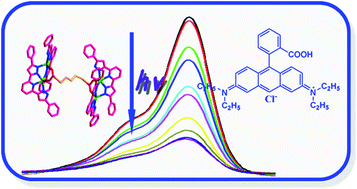Three novel d7/d10 metal complexes with N-heterocyclic ligand of 2,6-bis(3-pyrazolyl)pyridine: synthesis, structure, surface photovoltage spectroscopy and photocatalytic activity†
Abstract
By introducing dicarboxylate acid ligands with flexible chains of different lengths as a second organic ligand, three complexes [Co2(μ2-ox)(H2L)2(HCOO)2] (1), [Co2(μ4-ad)0.5(HL)2]·(OH)·(H2O) (2), [Zn2(μ4-sub)0.5(HL)2]·(OH)·(H2O) (3) (H2L = 2,6-di-(5-phenyl-1H-pyrazol-3-yl)pyridine, ox = oxalic acid, ad = adipic acid, sub = suberic acid) were synthesized by a hydrothermal method. All complexes were characterized by elemental analysis, IR and UV-vis spectroscopy and single-crystal X-ray diffraction. Structural analysis reveals that in complex 1, the Co(II) atom was six-coordinated to form a distorted octahedron, while in complexes 2 and 3, the Co(II) and Zn(II) atoms were five-coordinated to form disordered tetragonal coordination geometries. Acting as a bridged ligand, the flexible dicarboxylate acid ligand in complex 1 coordinated with two metal atoms, while in complexes 2 and 3 it coordinated with four metal atoms. The surface photovoltage spectroscopy and photocatalytic activities of complexes 1, 2 and 3 were also investigated in detail.


 Please wait while we load your content...
Please wait while we load your content...